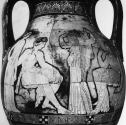220499, ATHENIAN, New York (N.Y.), Metropolitan Museum, 37.11.23
- Vase Number: 220499
- Fabric: ATHENIAN
- Technique: RED-FIGURE
- Shape Name: PELIKE
- Provenance: ITALY, SICILY
- Date: -450 to -400
- Inscriptions: Named: DEIOPE, ERATO, MELPOMENE, KALLIOPE, TERPSICHORA, HARMONIA
- Attributed To: MEIDIAS P by RICHTER
- Decoration: A: MOUSAIOS, IN PATTERNED CHITON SEATED WITH KITHARA, WOMAN (NAMED) WITH BIRD, CHILD (EUMOLPOS), MUSES, WITH TYMPANON, LYRE AND HARP (NAMED, ERATO, MELPOMENE, KALLIOPE, TERPSICHORE, HARMONIA), APHRODITE SEATED, EROTES
B: HERAKLES (BEARDLESS) SEATED, AND DEIANEIRA (BOTH NAMED) BETWEEN WOMEN, ONE SEATED - Current Collection: New York (N.Y.), Metropolitan Museum: 37.11.23
- Publication Record: American Journal of Archaeology: 43 (1939) 2-3, AT 4, FIGS.1-3
Beazley, J.D., Attic Red-Figure Vase-Painters, 2nd edition (Oxford, 1963): 1313.7
Beazley, J.D., Paralipomena (Oxford, 1971): 477
Bundrick, S.D., Music and Image in Classical Athens (Cambridge, 2005): 55, FIG.32 (A)
Burn, L., The Meidias Painter (Oxford, 1987): PLS.35-37 (A,B,PARTS)
Carpenter, T.H., with Mannack, T. and Mendonca, M., Beazley Addenda, 2nd edition (Oxford, 1989): 362
Giudice, F. and Panvini, R. (eds.), Il greco, il barbaro e la ceramica attica, Immaginario del diverso, processi di scambio e autorappresentazione degli indigeni, Volume primo, Atti del Convegno Internazionale di studi, 14-19 maggio 2001, Catania, Caltanisetta, Gela, Camarina, Vittoria, Siracusa (Rome, 2010): 61, FIG.7A-C (A, PART OF A, B)
Lexicon Iconographicum Mythologiae Classicae: IV, PL.25, EUMOLPOS 1, PL.241, HARMONIA 13 (A, PART OF A), PL.559, HERAKLES 1681 (A)
Lexicon Iconographicum Mythologiae Classicae: VII, PL.394, POTHOS I 3 (PART), PL.180, PEITHO 30 (PART OF A)
Maas, M. and Snyder, J.M, Stringed Instruments of Ancient Greece (New Haven, 1989): 160, FIG.10 (PART OF A)
Maas, M. and Snyder, J.M, Stringed Instruments of Ancient Greece (New Haven, 1989): 164, FIG.16 (PART OF A)
Prospettiva Rivista dell' arti antica e moderna (Siena): 70 (1993) 17, FIG.32 (A)
Shapiro, H.A., Personifications in Greek Art, The Representation of Abstract Concepts 600-400 BC (Zurich, 1993): 107, 204, FIGS.59, 165 (A, PART OF A)
Smith, A.C., Polis and Personification in Classical Athenian Art (Leiden, 2011): FIG.5.9 (A)
Tsiaphaki, D., I Thraki stin attiki eikonographia tou 5ou aiona p. Ch., Prosengiseis stis scheseis Athinas kai Thrakis (Komotini, 1998): 353, FIG.31 (A) - AVI Web: https://www.avi.unibas.ch/DB/searchform.html?ID=5880
- AVI Record Number: 5657
- LIMC ID: 12145
- LIMC Web: http://ark.dasch.swiss/ark:/72163/080e-744fa54efa147-4
- CAVI Collection: New York 37.11.23.
- CAVI Lemma: RF pelike. From Sicily. Meidias Painter. Late fifth.
- CAVI Subject: A: Musaeus with family; four Muses; Aphrodite with companions. B: Heracles
and Deianeira.
- CAVI Inscriptions: The inscriptions are often above the heads. A: Μοσ[αι]ος. Δηιοπη. Ευμολπος.
Μελ̣πομενη. [Ε]ρατω{2}. Ποθος. Καλλιοπη. Αρμονια. Αφροδιτ̣η. Τερψιχορα. Πειθω.
B: Δηιανειρα. κα[λη]{3}. Ηρακ[λη]ς. At the top of the picture, below the
palmettes, are faint traces of an illegible inscription, which Beazley thought,
because of its position, might be a signature.
- CAVI Footnotes: {1} fig. 3 has the inscriptions repainted in white by Hall. {2} irregular
spacing. {3} Deianeira's name is above Heracles; kale is above Deianeira and
apparently not related to her name. Is it perhaps related to another woman?
- CAVI Comments: For the relations of the personages, see Milne apud Richter (1939). Robertson
discusses the Meidian treatment of the myth. Shapiro: the theme of A is music at
the wedding of Harmonia, who settles in the Attic landscape (the Attic singer
Musaeus!). Cf. `harmonia' in Euripides, Medea 830-32. The vase mixes the Theban
Harmonia with the companion of Aphrodite. Burn 33: Peitho is the only companion
that is seated. 54: Musaeus is connected with the Eleusinian mysteries: Deiope
was a priestess of Demeter, her son Eumolpus is the ancestor of the Eumolpidae.
See also L. Weidauer, `Eumolpos und Athen,' AA 1985, 195-210, and LIMC iv, s.v.
Eumolpos. Musaeus is here in Thracian costume, with five muses. Ionic alphabet.
- CAVI Number: 5657
- AVI Bibliography: Richter (1939), 1 ff., figs.1-3{1}. — ARV[2] (1963), 1313/7. — Para. (1971),
477. — LIMC ii (1984), Aphrodite 1264, 1518. — Burn (1987), 54-55, 98/M 7, pls.
35-37. — Burn (1987), 54f. and 98/M 7, pls. 33-37. — LIMC iv (1988), Eumolpos
1*, Harmonia 13*, Herakles 1681*. — Add.[2] (1989), 362. — AttScr (1990), no.
808. — Robertson (1992), 239. — LIMC vi (1992), Mousa, Mousai 93, Mousaios 13. —
Shapiro (1993), 106ff., 241/48, 107, fig. 59, 204, fig. 165 (Peitho). — LIMC vii
(1994), Peitho 30*, Pothos I/3*
- CAVI / AVI Data from Henry Immerwahr's Corpus of Attic Vase Inscriptions (CAVI), updated by Rudoph Wachter's Attic Vase Inscriptions (AVI)







Link to this record using the address https://www.beazley.ox.ac.uk/record/66FB43F5-A7C4-4C50-86FB-5315F817A80E